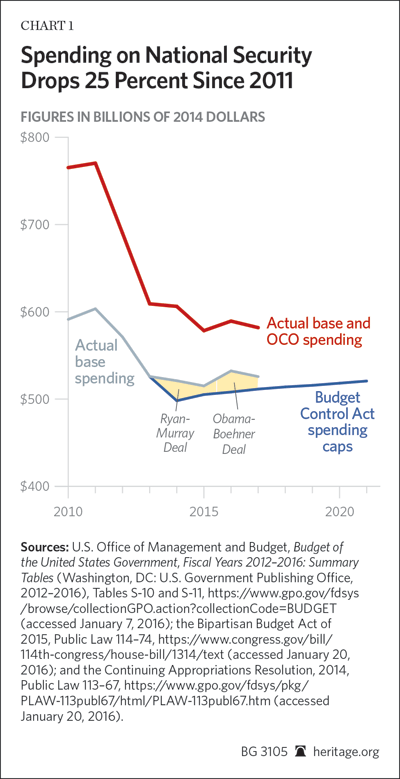The National Defense Authorization Act (NDAA) is an annual bill that sets policies and budgets for the U.S. Department of Defense (DOD). This bill and the defense appropriations bill are Congress’s two annual major pieces of defense legislation. With the release of the Obama Administration’s fiscal year (FY) 2017 budget request, Congress has begun working on the NDAA.
National security should always be the federal government’s top priority. Reading the Constitution, the Federalist Papers, or our Founders’ other writings confirms the priority they placed on “providing for the common defense.” They were also clear that the goal of a strong national defense is not war, but peace. As George Washington said, “to be prepared for war is one of the most effectual means of preserving peace.”[1] Liberty and the pursuit of happiness are dependent on America’s ability to provide peace and security for its citizens.
The Status of the U.S. Military
Years of budget cuts have resulted in a smaller and weaker military. The Heritage Foundation’s 2016 Index of U.S. Military Strength graded the U.S. military’s capability, capacity, and readiness and found that as a whole it is only “marginal.”[2] In fact, both the Army and the Air Force dropped in their rating from the previous year due to capacity and readiness cuts. In short, our military today is not able to adequately provide for America’s national security needs.
Unfortunately, rebuilding America’s military strength is not as simple as increasing the budget for a year or two. Rebuilding a unit, buying new equipment, or increasing a unit’s readiness can take years. In light of this reality, Congress and a new Administration need to address the gap in capabilities. Heritage experts have proposed a “gap strategy” which focuses on three things: strengthening enduring alliances, rebuilding defense, and making America the engine of global economic freedom.[3] In the NDAA, Congress can work on the first two—rebuilding defense and strengthening alliances.
Beginning to Rebuild America’s Military
The first overarching priority for the NDAA should be rebuilding America’s military power. As already outlined, defense budget cuts have led to a significant decrease in military capabilities and readiness, as well as investment in future research and development.
As Congress develops the NDAA, six principles should guide its Members’ work:
-
Restore cuts to capacity, particularly U.S. ground forces. Cutting military capacity, such as the number of ships, planes, or soldiers, is often attractive, as it can quickly produce significant savings. Pursuing immediate savings, however, comes at significant long-term expense: rebuilding military capacity will take longer and cost even more. Even more important, the U.S. military is already too small and further capacity cuts will severely impact its ability to conduct missions around the globe.
-
Prioritize readiness for all the services. A measure of how prepared a military unit is for combat, readiness is achieved by pilots flying necessary hours, ground forces conducting necessary training, and sailors and their ships steaming a sufficient number of days in support of fleet exercises. In tight budgets, the military’s readiness often suffers as training and maintenance can be cut more easily than personnel or long-term contracts. Lower readiness levels means that either the U.S. has fewer planes, ships, and soldiers to send on a mission, or those same service members are sent into danger without the proper equipment and training. The 2016 Index of U.S. Military Strength rated the readiness of the Navy, Air Force, and Marine Corps as “marginal,” and the readiness of the Army as “weak.” With this in mind, Congress should increase defense spending with explicit guidance that an increased amount should be directed to improving readiness.
-
Shift initiatives from the Overseas Contingency Operations (OCO) account to the baseline defense budget. The OCO account has been increasingly used as a means of circumventing budget cuts and spending caps imposed on national defense. While the desire to increase defense spending is a good one, it should be done through the normal defense budget, not through OCO. The OCO account (and its predecessors) were established in response to specific new threats and are technically considered “emergency” spending to circumvent spending caps. The Department of Defense now submits an annual OCO request along with its base budget request. The defense budget should be increased to fully incorporate OCO needs without decreasing the underlying defense budget. As outlined below, the FY 2017 defense budget should be at least $600 billion plus the full costs of OCO.
-
Increase funding for updating nuclear weapons and missile defense systems. In the face of growing ballistic missile threats and other nations’ nuclear weapon capabilities, U.S. nuclear weapons and missile defense capabilities remain essential. A modern, flexible, and capable nuclear weapons posture is vital to keeping the U.S. safe, allies assured, and enemies deterred.
-
Provide stability for modernization programs. The U.S. must continue to invest in improving its current military capabilities and developing future capabilities. The military did not invest in modernization sufficiently during much of the past two decades, and significant modernization investments were also squandered due to mismanagement and misguided priorities. As a result, many old platforms are simultaneously approaching the end of their functional capacity. Funding stability and strong management and oversight are vital to achieving the necessary modernization.
-
Increase the national defense budget. As outlined below, the Bipartisan Budget Act of 2015 slightly increased the cap on defense spending. For FY 2017, the national defense budget (function 050) is now capped at $551 billion, plus $59 billion in Overseas Contingency Operations (OCO) funding. Instead, Congress should increase the base defense budget to at least $600 billion in FY 2017 with the full cost of overseas operations added on top.
There is a wide range of specific steps that can be taken in the NDAA in keeping with these principles for rebuilding the military. They can be categorized as follows: service-specific actions, needed systemic changes, capabilities to protect or invest in, and bad policies to avoid or eliminate.
Service-Specific Actions
Army: Reverse Force Structure Cuts and Increase Readiness. The size of the Army has been cut dramatically in recent years. From a peak size of 570,000 soldiers in 2011, the Army has shrunk to 490,000 at the end of FY 2015 and is on the way to 475,000 at the end of FY 2016, 460,000 at the end of FY 2017, and 450,000 by the end of FY 2018.[4] The Army is struggling to meet the mission at 490,000 and further cuts will only make matters worse. At the same time, Army leaders have testified that only one-third of Army brigade combat teams are ready for combat, and the bulk of those ready for combat are already committed to ongoing operations. Instead of further cuts, Congress should start growing Army force structure and increase the Army’s readiness.
Navy: Do Not Retire Ships Early. In recent years, the Navy has proposed retiring ships before the end of their service life as a means of saving money. The Navy fleet is already too small and prematurely retiring ships will only further shrink the fleet. Congress should continue to grow the Navy fleet and prohibit early retirement of ships that can still contribute to the Navy’s mission.
Air Force: Do Not Retire Aircraft Prematurely. Similar to the Navy, the Air Force has proposed retiring various whole fleets of aircraft in recent years, such as the U-2 and the A-10, primarily for financial reasons. While retiring a whole fleet may produce significant savings, accomplishing the mission successfully must be a higher priority. Congress should not allow the Air Force to retire entire fleets of aircraft unless there are alternative platforms available to successfully accomplish the relevant mission.
Marine Corps: Restore Force Structure. Similar to the Army, the Marines Corps has been steadily reducing in size. In FY 2016 the Marine Corps end-strength will be 184,000, down from a high of 202,786 in FY 2009 and is expected to drop to 182,000 in FY 2017.[5] The Marine Corps has determined that an end-strength of 186,800 is needed to assure that Marines have adequate rotation schedules. However, even at that level, the Marines are stretched very thin. Congress should consider increasing the size of the Marine Corps force structure.
Systemic Changes
The Department of Defense is the largest employer in the country, and perhaps the biggest in the world.[6] Such a large organization must develop a range of systems and practices for everything from health care to acquisition to property management. Many of these DOD systems are outdated, inefficient, and potentially less than effective. Improving DOD systems, an effort some observers call “defense reform,” is often seen as an effort to save money. This is the wrong way to think about defense systems reform. Instead, the goal should be to improve the effectiveness of the organization. In an organization that is charged with protecting this country and asks men and women in uniform to put their lives at risk, mission effectiveness should always be the primary goal. Financial efficiency and responsibility is important, but these goals must not supersede the mission. As Congress considers defense reform proposals in the FY 2017 NDAA, Congress should:
-
Improve the military health care system. The current military health care system limits the ability of service members and their families to choose health care providers and often makes access to allowed providers difficult. Across a range of measures, service members and their families’ access to care is worse than in the private sector and satisfaction with the care they receive is lower than in the private sector.[7] Access and satisfaction are not the only concerns, however. As the Military Compensation and Retirement Modernization Commission (MCRMC) has noted, much of the work done by military medical staff in peacetime is not good training for wartime. For example, the predominant inpatient services provided at military hospitals are for pregnancy, childbirth, and newborn care. Military families should be well cared for, but pediatric care is not the best preparation for the types of procedures that military medical professionals will be performing during a time of conflict.[8]
The MCRMC has proposed replacing the current military health system with one that focuses military medical providers on the key capabilities that they must have, while increasing reliance on the private sector to provide better access and care for routine medical care for service members and their families.[9] A Heritage analyst proposed a similar move toward the private sector.[10] Congress should develop a military health care system that increases service member and family access to private-sector medical care, improves health care readiness, and makes health care more affordable.
-
Reform the size of the DOD’s civilian workforce and hold them accountable. While the FY 2016 NDAA directed significant reductions in DOD headquarters, the ratio between civilian and military employees in the DOD will continue to be debated. The uniformed military has been downsized over recent years due to budget cuts, but the DOD civilian workforce has not faced similar reductions. Any discussion of the civilian workforce should keep in mind that civilian employees are actually more affordable than military personnel and it may make financial sense to convert some positions to civilian or contract positions.[11] There is no one-size-fits-all solution for the military-civilian-contractor mix, and the goal should always be increased mission effectiveness. Mission effectiveness should also mean that civilian employees are held responsible for their performance, and low-performing civilians should be let go.[12] Congress should ensure that the DOD is working toward a workforce designed to accomplish the mission effectively.
-
Review DOD infrastructure. DOD leaders regularly argue that excess basing capacity is a financial burden and have called for a new round of base closures. However, much of the DOD’s supporting data are a decade old, and may not reflect current and future basing needs. In the FY 2016 NDAA, Congress directed a new capacity study to review the DOD’s current basing capacity as well as the current and future needs for bases.[13] Congress should build on this study by allowing the DOD to identify a handful of bases or installations where closing or relocating would produce significant financial savings or increased mission effectiveness within a short and well-defined time period.
Functional and Capability Priorities
In addition to preserving capacity and addressing some systemic challenges, Congress should work on a number of functional and capability priorities in the FY 2017 NDAA. These include:
-
Dedicate units and resources to robust experimentation. The Secretary of Defense and the service chiefs should formally organize and resource an experimentation force. The size of this effort need not be large, and could, for example, comprise an Army brigade combat team (BCT), a Marine regiment, and similar or corresponding units from the Navy and Air Force. Such a representational force could be large enough and capable enough to experiment with operational concepts, new technologies, and methods for integrating and leveraging the combat power and capabilities of the joint force. Too often such efforts are sporadic and so limited in duration that true insights cannot be gained over time. Experimentation is an iterative process, necessary to identify problems, possible solutions, and reveal unanticipated possibilities. Such efforts also need stable attention from a command structure and participants able to maintain focus across multiple iterations. At present, the military does not have the capacity or organizational stability to make such investments.[14]
-
Improve collaboration among—and between—experimentation and research and development organizations. The Department of Defense and individual military services have a number of agencies dedicated to research and development of promising technologies and initial experimentation with such. These agencies include the Defense Advanced Research Projects Agency (DARPA), U.S. Navy Research Laboratory, U.S. Army Research Development and Engineering Command, Army Capabilities Integration Center, Air Force Research Laboratory, and the Marine Corps Warfighting Laboratory, among many others. Each organization explores material solutions to problems identified by the services, although some, like DARPA, take on broader non-service-specific efforts. Without diminishing their core focus, their capabilities and capacity should be expanded to enable them to more effectively collaborate with each other, with specific emphasis placed on collaborating with the experimentation force. Related to this is the need to expand defense acquisition options for rapid introduction of early prototypes into the experimentation force.[15]
-
Retain commonsense restrictions on the Obama Administration’s ability to transfer detainees at Guantanamo Bay. Since 9/11, the United States has been engaged in an armed conflict against al-Qaeda, the Afghan Taliban, and associated forces. One of the flashpoints of controversy and debate over U.S. conduct in this war is the detainment of enemy combatants. The U.S. detains captured enemy fighters, not as punishment, but to keep them from returning to the battlefield. Detaining select enemy combatants during wartime, under safe, secure, and humane conditions, is vital for this war and any future armed conflict.
The Administration has the legal authority to hold those detainees who have lost their habeas corpus lawsuits before the court, and should continue to do so. While some in Congress have supported a path to closing the prison at Guantanamo Bay, the FY 2016 NDAA contained strong legal restrictions on what the Obama Administration could do with the Guantanamo detainees. The FY 2017 NDAA should continue to place commonsense restrictions on the Obama Administration and provide guardrails on the transfer of Guantanamo detainees. Congress should:
- Continue to require 30 days’ notice to Congress before a detainee is transferred from Guantanamo;
- Continue to prohibit the use of appropriated funds to construct or modify any facility in the United States, its territories, or possessions to house any Guantanamo detainee in the custody or control of the Department of Defense; and
- Continue to prohibit the use of appropriated funds to transfer Guantanamo detainees to the United States for any purpose.
-
Improve the DOD’s cyber capabilities. The U.S. military has been one of the largest, if not the single largest, adopters of technologically advanced devices. From communications systems to weapons guidance systems, the DOD has adopted new, powerful technologies that make the military more effective, efficient, and responsive. Since the U.S. reaps tremendous benefits from modern systems, it must do more to secure such systems and prevent enemies from exploiting any potential U.S. cyber vulnerabilities. Furthermore, the U.S. must leverage its strengths in cyber operations for offensive purposes where needed. To this end, Congress should use the NDAA to:
Another example of cyber aggression can be seen in Ukraine, where as many as 700,000 people lost power to what is believed to be the first case of a cyber weapon taking down a power grid—an attack attributed to a Russian hacking group.[19] Given increasing Russian malicious behavior in cyberspace, the U.S. should limit cooperation with Russia. It is naive for the U.S. to cooperate on cybersecurity with nations that are actively stealing its military and economic secrets through cyber espionage and other malicious hacks. While DOD officials have expressed concerns over how such limitations might affect their meetings with Russian and Chinese counterparts, it should be possible to craft restrictions that stop specific examples of cyber cooperation while not overly impacting cooperation on other issues.[20]
- Encourage the private development of cybersecurity supply chain ratings and accreditation. While the DOD is arguably the most reliable government protector of the cyber supply chain, there is more work to be done. Ratings should be based on a private-sector set of best practices such as that developed by the Open Group, to which the DOD is a contributor. A specific way to encourage the adoption of this system would be to require government agencies that have security-related duties, such as the DOD, to purchase technology only from organizations that are accredited by this cyber supply chain ratings system.[16]
- Continue to develop defensive and offensive cyber capabilities at U.S. Cyber Command and within the combatant commands and services. Cybersecurity and operations are not merely Internet technology activities that the military can assign to a department to handle. Each part of the military has a need for defensive cyber capabilities, and many also have the need for offensive capabilities. At the same time, U.S. Cyber Command is critical for ensuring leadership and a centralized command for cyber operations.
- Reject cybersecurity cooperation with malicious nation-states. In 2015, the U.S. came to a new agreement with China on cyber cooperation.[17] This agreement came despite ongoing malicious cyber activity attributed to China, such as the hack of the Office of Personnel Management and sensitive records of 22 million individuals.[18] Despite implausible assurances from the Chinese government that it never has and never will engage in cyber economic espionage, the U.S. should use all tools at its disposal to punish aggressive Chinese actions online, including ceasing the new dialogues established by the most recent agreement so long as China continues to hack U.S. companies.
-
Strengthen U.S. nuclear deterrence capabilities. A modern, flexible, and capable nuclear weapons posture is essential to keeping the U.S. safe, its allies assured, and its enemies deterred. In order to improve the U.S. strategic posture, Congress and the Pentagon should:
- Oppose misguided arms reductions. Congress should not provide funding for implementation of agreements that put the U.S. at a disadvantage and that do not benefit U.S. national security—agreements such as the New Strategic Arms Reduction Treaty, and the Intermediate-Range Nuclear Forces Treaty, which Russia is violating. Congress should not provide funding for unilateral nuclear weapons–reduction efforts while all other nuclear players are modernizing and expanding their arsenals.
- Modernize U.S. nuclear weapons. U.S. nuclear weapons and delivery systems are aging and in need of investment. If they are not modernized, the U.S. will soon have inadequate nuclear weapons infrastructure and inadequate nuclear delivery platforms. Further delays increase the overall costs of the programs and leave the U.S. less capable of responding to unexpected developments in the nuclear programs of other nations.
- Consider the benefits of yield-producing experiments for the U.S. nuclear weapons program. Conducting very-small-scale, yield-producing experiments would benefit the science that underpins the program, and the U.S. could gain important benefits; indeed, China and Russia are already conducting such experiments.[21]
- Advance a “protect-and-defend” strategic posture. At the core of today’s world is a fundamental asymmetry between the values of the U.S. and the values of its adversaries. While the U.S. values the lives of its citizens, economic prosperity, and institutions, U.S. adversaries value leadership survival above all. The U.S. should develop precise means to credibly threaten that which its adversaries value, and deploy both passive and active defenses to remove the benefits that adversaries might gain by attacking the U.S. or its allies.
- Re-evaluate U.S. strategic nuclear posture. The Pentagon currently bases its nuclear posture on the notion that “Russia and the United States are no longer adversaries, and prospects for military confrontation have declined dramatically.”[22] In light of Russia’s demonstrated recklessness in Ukraine and its nuclear weapons modernization steps, this posture is no longer valid.
-
Continue developing a layered, comprehensive missile defense system. The system should be able to address various ranges of ballistic missiles in various threat scenarios. Currently, the U.S. continues to lag behind the ballistic missile threat. Space-based interceptors provide the best opportunity to accomplish these tasks at the best cost-per-interceptor ratio. This should also include:
- Deploy an X-band tracking radar to a European host nation that is a NATO member. The U.S. has previously determined the Czech Republic to be the ideal country for tracking incoming ballistic missiles from Iran. The radar would improve the capability of U.S. homeland missile defense systems, and it would serve as a visible reminder of U.S. commitment to European security.
- Encourage NATO allies to enhance their ballistic missile and air defense capabilities. Allies can participate in the U.S. ballistic missile defense program in various ways, including making their ships (where applicable) compatible with the U.S. Aegis weapons system.
Ineffective Policies and Programs to Avoid, Remove, or Cut
Part of rebuilding the military is getting rid of ineffective policies implemented by Congress or the Administration. Equally important, Congress must avoid the temptation to impose new policies that might hurt national security as it seeks to counteract bad policies from the Administration. Congress should:
-
Remove the energy mandate. The FY 2010 NDAA required that 25 percent of DOD facility energy use be generated by renewable sources by 2025. To enact this mandate, the DOD has committed to developing 3 gigawatts of renewable energy on Army, Navy, and Air Force installations.[23] They have implemented renewable energy initiatives, such as solar photovoltaic energy systems, across more than 31 states.[24] This mandate does not contribute to warfighting capabilities or consider the costs it will impose on the services to implement these systems. Furthermore, the 25 percent mandate provides little flexibility for the DOD to manage energy costs, especially given the decreasing price in oil. One of the DOD energy strategy’s principles is to “reduce the demand for energy in military operations.”[25] Yet initiatives like the Navy’s investment in biofuels do nothing to accomplish this reduction of demand.[26] This alternative fuel source is much costlier than conventional oil, and it is neither more readily available across the globe nor is it more fuel-efficient. This policy, therefore, imposes excessive costs on the service while failing to enhance any naval capability. The DOD energy strategy should reflect warfighters’ needs and remove inappropriate initiatives, which impose unnecessary costs on its strained budget. Congress can facilitate this by repealing the 25 percent mandate and allowing the military to determine how to manage its energy enterprise in the most efficient and effective manner.
-
Exempt DOD from Davis–Bacon. The Davis–Bacon Act requires that construction contractors pay prevailing wages when working on projects for the federal government.[27] However, the prevailing wage rates used by the government “bear no resemblance” to actual market wages.[28] In short, the Davis–Bacon Act increases the cost of federally funded construction by 9.9 percent. The increased cost of construction is significant for the DOD, which requested $8.4 billion for construction projects in FY 2016.[29] Congress should exempt the DOD from Davis–Bacon requirements to ensure that military construction projects are as affordable as possible.
-
Oppose treaties that harm national security. The Arms Trade Treaty and the Anti-Personnel Mine Ban Convention (commonly known as the Ottawa Convention) could have significant effects on national security. Congress has not ratified either of these treaties and should be wary of any effort by an Administration to implement either of them before they are properly ratified.
-
Arms Trade Treaty (ATT). The U.S. has not ratified the ATT, and a bipartisan majority of the Senate opposes its ratification on the grounds that it is vague, easily politicized, and could hinder the U.S. in fulfilling its commitments to provide arms to key allies. Many other leading arms exporters and importers also oppose the ATT, but despite its own assertion that any ATT that did not include all U.N. members would be “less than useless,” the Obama Administration signed the ATT in 2013.
Congress should reiterate its previous rejections of funding to implement the ATT, and should in addition prevent the ATT from being used as the basis for domestic prosecutions, ban U.S. financial contributions to the ATT’s Secretariat, and require that the ATT ratification process include House and Senate implementing legislation. Finally, it should condition the payment of fees to attend the ATT’s annual conferences on Administration acknowledgement that the U.S. will not implement the ATT prior to the completion of the full ratification process.
-
Anti-Personnel Mine Ban Convention. The U.S. has not ratified this Convention—the treaty has never even been submitted to the Senate. U.S. anti-personnel landmines meet or exceed all relevant international standards, and the U.S. employs such landmines responsibly. Studies by NATO and other organizations confirm their military utility, and in 2014, the Chairman of the Joint Chiefs of Staff stated that anti-personnel landmines remain “an important tool in the arsenal of the armed forces of the United States.” But in June 2014, the Obama Administration banned their use outside the Korean Peninsula.
In the FY 2016 NDAA, Congress prohibited the destruction of U.S. anti-personnel landmine stockpiles before the Department of Defense completes and, by May 23, 2016, publishes a comprehensive study on Department policy on the use of landmines. This study will contain a 10-year inventory and cost projection for current stockpiles, a similar projection for replacement munitions, and an assessment of the effects of the projected inventory on operational plans.
Additionally, Congress should require that the Department report on the current state of research into operational alternatives to anti-personnel landmines, and should continue to ban funding for the destruction of existing stockpiles until Congress certifies that the replacement of anti-personnel landmines by alternative munitions will not endanger U.S. or allied forces or pose any operational challenges.
-
-
Avoid protectionism and “Buy America” policies. “Buy America” is a great bumper sticker and political slogan, but it is bad economic and security policy. The concept is simple: The Department of Defense (DOD) should buy from American companies and suppliers. Economically this makes no sense. Protectionist policies like Buy America—or tariffs that protect specific industries—hurt the U.S. economy more than they help.[30] Protectionist policies also mean that the DOD, and therefore American taxpayers, pay more for a given product or service.
- Oppose attempts to expand Buy America laws overseas. Buy America provisions do not make economic sense. From a national security perspective, the DOD already has the authority and flexibility to avoid relying on potential adversaries for critical resources or capabilities. Free and open competition among friendly countries will produce the best products and best prices.
- Oppose efforts to impose Buy America laws on successful partnerships with allied countries. There is no national security reason to exclude companies in allied countries from competing for DOD contracts.[31]
-
Cut non-defense research funding. The Defense Department has the largest research and development budget of the federal government, equaling roughly $70 billion a year. While the vast majority of this amount goes toward developing advanced military systems or technologies that have battlefield applications, each year, the DOD spends money on various projects that have no reason to be funded from the defense budget. In many cases, these projects are already being funded by other federal departments. Congress is unfortunately a significant part of the problem. Congress regularly adds hundreds of millions of dollars to research unrelated medical issues or popular agenda items, like alternative energy, that are not related to the combat mission of the military. Congress should preserve DOD research funds for efforts that directly impact the military mission.
-
Reduce commissary subsidies and combine commissary and exchange systems. The DOD operates two parallel but similar organizations for providing service members and their families with access to goods and groceries. The commissaries provide groceries at cost plus 5 percent, which requires an annual subsidy to be sustainable.[32] In FY 2016, Congress increased the subsidy for commissaries to $1.4 billion.[33] At the same time, the military exchanges operate largely without subsidies by passing appropriate costs on to the consumers. Maintaining access to affordable groceries and goods is important for service members, particularly those stationed overseas or in remote locations in the United States. Congress can provide this access more efficiently by combining the commissary and exchange systems and reducing the subsidies provided to the commissaries.
-
Prohibit increased military-to-military activities with Cuba. Given the Cuban military’s destabilizing role in the region, particularly its human rights record and direct support of Venezuela’s security services, Congress should prohibit any increased military-to-military cooperation between the U.S. and Cuba. Despite the Administration’s radical policy of normalization with the Castro regime, Congress should not perceive bilateral relations to be amicable. The Cuban government is hostile to U.S. interests and the norms established in the Western Hemisphere. Military-to-military cooperation should only be established when Cuba meets the standards for lifting the embargo and the Cuban military officials indicted in the murder of Americans killed in the Brothers to the Rescue 1996 shootdowns are brought to justice.
The Defense Budget
While the NDAA is primarily a policy bill, it also establishes budgets. This paper is not primarily about the budget, but the budget situation must be addressed. From FY 2011 to FY 2015, total national security spending (budget function 050, including overseas operations) dropped by 24.9 percent in real terms.[34] While that period included dramatic force reductions in Iraq and Afghanistan, recent events around the world and the operating tempo of the U.S. military show that this dramatic cut was misguided. Under the Bipartisan Budget Act of 2015 (BBA), defense spending increased slightly for FY 2016; thus FY 2011–FY 2016 is now only a 23.5 percent cut. Unfortunately, the BBA cap reduces inflation-adjusted defense spending in FY 2017, so the gap from FY 2011 grows back to 24.5 percent in real terms. The defense budget under the BBA is not sufficient to support the military that this nation needs.
While the national debt is a serious problem, the defense budget is not driving America’s debt. Even if the U.S. does not spend another dollar on national security, the national debt would continue to grow.[35] To be certain, the national debt is a significant drag on the economy and will make life much worse for future generations. However, the U.S. faces real and potentially deadly threats today and in the near future that it must address. Defense of this nation should be a top priority for Congress and all Americans.
Strengthening America’s Alliances
The NDAA is a defense policy bill, but many of those policies have a direct impact on the U.S.’s relationship with other countries. As Congress writes the NDAA, it should focus on strengthening alliances in the three critical regions of the world that most impact the United States: Europe, Asia, and the Middle East.
Europe and NATO. Russia is the largest geopolitical challenge in Europe, and strengthening America’s alliances in Europe requires a response to Russia. A team of Heritage analysts has proposed a comprehensive strategy toward Russia which Members of Congress can use as a blueprint for developing the NDAA.[36] While the comprehensive strategy outlines a wide range of steps that the U.S. should take to counter Russian aggression and support a strong Europe, Congress should start with the following principles:
- Demonstrate U.S. commitment to NATO and Euro-Atlantic security. At a time when Russia has shown the most aggression against NATO members in a generation, the Alliance needs American leadership and commitment.
- Reward key U.S. allies with closer defense cooperation. Instead of reducing the numbers of U.S. military bases in Europe, the U.S. should be looking at the potential for establishing new bases—especially on the periphery of Europe and with allies who have been committed to Euro-Atlantic security, particularly the Baltic states.
U.S. troop levels in Europe have been steadily reduced. As a part of an analysis of the need for U.S. ground troops, Heritage analysts have recommended increasing forces in Europe.[37] Congress should:
- Return to a 2012 baseline for ground troop numbers. The U.S. should return the two heavy BCTs to Europe, which would bring the total number of U.S. BCTs in Europe back to four. These forces do not have to return to their previous home bases in Germany, but could be placed in newer NATO members in Central and Eastern Europe.
- Carry out a strategic review of U.S. interests in Europe. After returning to the 2012 baseline, the U.S. should carry out a proper review of its total force requirement for Europe. This review, not the arbitrary need to cut the defense budget, should then guide the important decisions, such as the number of bases and the distribution of troops in Europe.[38]
Asia. Asia faces a number of political and security challenges, ranging from an aggressive regime in North Korea and terrorist breeding grounds in southwest Asia, to territorial disputes and a rising China. The United States has strong allies in the region, starting with Japan, South Korea, and Australia, as well as the Philippines and Thailand. It has a near-alliance with Singapore and a growing security partnership with India. The principal goal for the United States in the region is:
- A stable, peaceful, and balanced region. Establish an order whereby all Asian countries can pursue their national interests without fear of coercive diplomacy, military threats, or being dictated to by any aspiring hegemon. Achieving these objectives requires increased intergovernmental dialogue with key players in the Asia–Pacific to deter North Korean threats and counter Beijing’s aggressive moves in support of its extensive and extralegal territorial claims.[39]
With this primary goal in mind, there are a number of practical policy items that Congress should work toward in the NDAA. Congress should:
- Maintain current U.S. military force levels in Asia and fully fund defense requirements. A strong U.S. Navy is essential to U.S. leadership in the region, and requires a healthy ship-building budget. But regional militaries want to interact with their ground force counterparts in the U.S. Army and Marine Corps as well. The presence of robust American forces in the Asia–Pacific region supports American efforts to engage Asian militaries in ways conducive to attaining American national interests.[40]
- Support the South China Sea Initiative. In the FY 2016 NDAA, Congress established the South China Sea Initiative to help the DOD partner with friendly and allied countries in the region to build greater maritime security and maritime domain awareness. Congress should closely monitor the implementation of this effort and consider expanding it.[41]
- Continue supporting Taiwan with defense materiel, particularly its effort to develop or acquire diesel submarines and new advanced fighter aircraft. Under the Taiwan Relations Act, it is the policy of the United States to “make available to Taiwan such defense articles and services in such quantity as may be necessary to enable Taiwan to maintain a sufficient self-defense capability.”[42] In the face of China’s ongoing comprehensive military modernization program, as well as Beijing’s growing assertiveness throughout the western Pacific littoral, the cross-strait balance has been steadily deteriorating in favor of the People’s Republic of China.
- Expand U.S. naval interoperability with key friends and allies. The U.S. military engages in a variety of bilateral and multilateral exercises with various friends and allies. These activities demonstrate that the United States is not an interloper in the region, but a valued partner. They also facilitate interoperability among forces in the event of future crises or conflict. The U.S. should maintain, and even expand, such exercises.[43]
- Encourage South Korea to accept a THAAD missile defense system. Deploying the Terminal High Altitude Area Defense (THAAD) system on the Korean Peninsula would enhance South Korea’s defense against potentially catastrophic nuclear, biological, and chemical attacks and advanced North Korean missile capabilities; impede Pyongyang’s ability to engage in coercive diplomacy; and augment deterrence by reducing the certainty of success of a potential North Korean missile strike.[44]
- Maintain current ground force levels in Afghanistan so long as conditions on the ground merit it. President Obama’s decision to extend temporary U.S. troop presence in Afghanistan was welcome, but all deadlines for withdrawal should be scrapped. A conditions-based approach should be taken instead.[45]
Middle East. The Middle East continues to be an area of major concern for the United States. The unstable region remains a key source of oil exports and enduring terrorist threats that will impact the economies and security of countries around the world for decades to come. The U.S. has both pressing immediate concerns, such as ISIS, and long-term concerns, like Iran, in the region. The two principal goals for Congress in the region should be:
- Reduce or mitigate Iran as a regional and global threat. Iran’s open hostility to the U.S., Israel, and other U.S. allies; sponsorship of Hezbollah and other Islamist terrorist groups; growing ballistic missile threat; and aggressive interventions in Syria, Iraq, and Yemen need to be countered and contained.[46]
- Eliminate terrorist control over large swaths of territory. The U.S. must aggressively ensure that terrorist groups do not exercise territorial control of key strategic regions. At present, the most significant threat to regional stability is the Islamic State (also known as ISIS), which has seized considerable territory in Iraq and Syria.[47]
With these primary goals in mind, there are a number of practical policy items that Congress should work toward in the NDAA. Congress should:
- Escalate military efforts to drive ISIS from Iraq. This should include the deployment of more special operations forces, trainers and embedded advisers and forward air controllers deployed with Kurdish Peshmerga militia forces, Sunni tribal militias, and Iraqi army forces. Air strikes need to be intensified. Conventional U.S. ground forces also may be required to remove ISIS’s territorial control and drive it out of Iraq.[48]
- Focus on preventing Iran from ever becoming a nuclear weapons state. Although Congress failed to halt the Iran nuclear deal, it can play an important role in holding Iran accountable for any violations of the agreement. It can hold hearings on Iran’s compliance with its nuclear commitments and the Administration’s response to Iranian violations. Congress should also pass new sanctions laws that will be triggered if Iran violates the agreement. But, ultimately only the credible threat of using military force can prevent Tehran from attaining a nuclear bomb. Congress must adequately fund the military to maintain and enhance this deterrence.[49]
- Strengthen military, intelligence, and security cooperation with Israel and the members of the Gulf Cooperation Council (GCC). The nuclear agreement has had a corrosive effect on bilateral relations with important U.S. allies threatened by Iran, such as Israel, Saudi Arabia, and other members of the GCC. Washington should safeguard the vital security interests of the U.S. and its allies by maintaining a favorable balance of power in the region and rebuilding security ties by boosting arms sales to Israel and the GCC, taking care that arms sales to Arab states do not threaten Israel’s qualitative military edge in the event of a flare-up in Arab–Israeli fighting.[50]
- Put a high priority on missile defense. Iran’s ballistic missile force, the largest in the Middle East, poses a growing threat to its neighbors. Washington should help Israel to strengthen its missile defenses and help the GCC countries to build an integrated and layered missile defense architecture to blunt the Iranian missile threat.[51]
Conclusion
The FY 2017 NDAA presents an opportunity for Congress to begin rebuilding the U.S. military while strengthening key alliances around the world. All of these recommendations combined would not immediately produce a strong U.S. military, but they will at least put the military back on the right track. Furthermore, future Congresses and Presidents will be able to build off these reforms, thereby continuing the restoration of the American military.




















